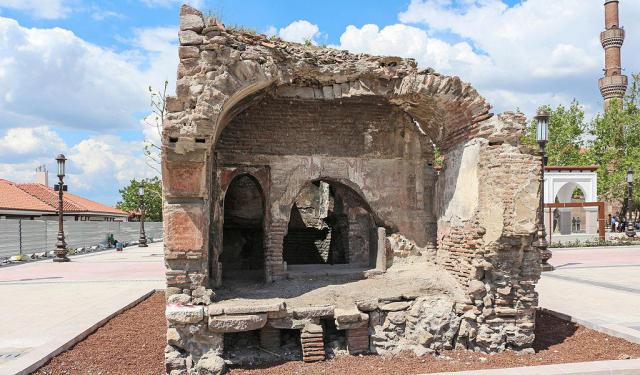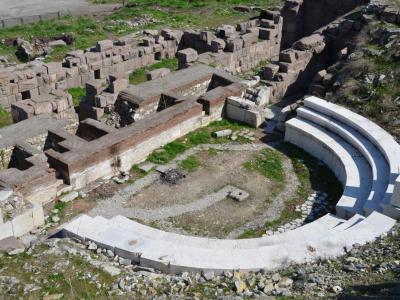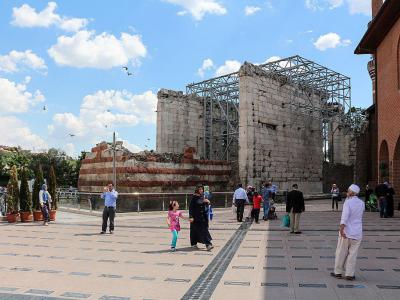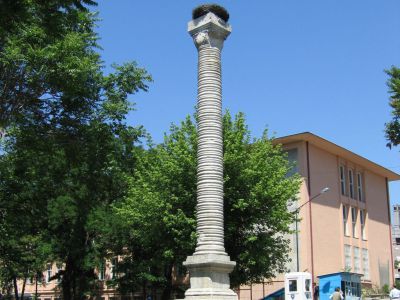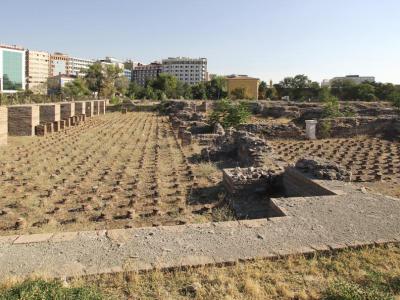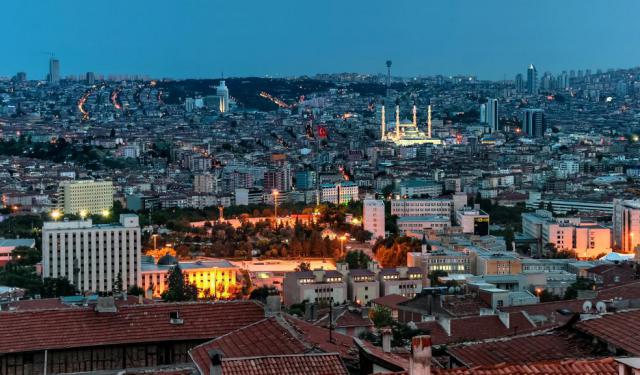Ankara Roman Ruins Walking Tour (Self Guided), Ankara
In 25 BC, Emperor Augustus annexed Ankara, then known as Ancyra, to the Roman Empire. Following that, the city, attached with considerable importance, was enhanced with fortifications and embellished with temples and elaborate civic buildings.
The most significant Roman landmarks, a testament to the Roman imperial cultural influence, survived to our days albeit ruined, include the Roman Theater which could once seat up to 15,000 spectators, and the Temple of Augustus and Rome, honoring the first Roman emperor, Augustus. The temple was turned into a church during the Byzantine period, and then a mosque, under the Ottomans, but today houses a museum.
The 15-meter-tall Column of Julian, erected in the 4th century AD, commemorates a visit to the city by Emperor Julian. Another relic, the Roman Baths, once used for socializing, relaxation, and hygiene, are among the most sizable remnants of Roman heritage in Ankara.
There is a popular saying, "Ankara is an open-air museum", which emphasizes the fact that the city has a rich historical background, a significant part of which comes from the Roman period. Should you wish to explore this museum yourself, at your own pace, and in your good time, feel free to give it a go on this self-guided walk.
The most significant Roman landmarks, a testament to the Roman imperial cultural influence, survived to our days albeit ruined, include the Roman Theater which could once seat up to 15,000 spectators, and the Temple of Augustus and Rome, honoring the first Roman emperor, Augustus. The temple was turned into a church during the Byzantine period, and then a mosque, under the Ottomans, but today houses a museum.
The 15-meter-tall Column of Julian, erected in the 4th century AD, commemorates a visit to the city by Emperor Julian. Another relic, the Roman Baths, once used for socializing, relaxation, and hygiene, are among the most sizable remnants of Roman heritage in Ankara.
There is a popular saying, "Ankara is an open-air museum", which emphasizes the fact that the city has a rich historical background, a significant part of which comes from the Roman period. Should you wish to explore this museum yourself, at your own pace, and in your good time, feel free to give it a go on this self-guided walk.
How it works: Download the app "GPSmyCity: Walks in 1K+ Cities" from Apple App Store or Google Play Store to your mobile phone or tablet. The app turns your mobile device into a personal tour guide and its built-in GPS navigation functions guide you from one tour stop to next. The app works offline, so no data plan is needed when traveling abroad.
Ankara Roman Ruins Walking Tour Map
Guide Name: Ankara Roman Ruins Walking Tour
Guide Location: Turkey » Ankara (See other walking tours in Ankara)
Guide Type: Self-guided Walking Tour (Sightseeing)
# of Attractions: 4
Tour Duration: 1 Hour(s)
Travel Distance: 1.4 Km or 0.9 Miles
Author: alexander
Sight(s) Featured in This Guide:
Guide Location: Turkey » Ankara (See other walking tours in Ankara)
Guide Type: Self-guided Walking Tour (Sightseeing)
# of Attractions: 4
Tour Duration: 1 Hour(s)
Travel Distance: 1.4 Km or 0.9 Miles
Author: alexander
Sight(s) Featured in This Guide:
- Ankara Roman Theater
- Temple of Augustus and Rome
- Column of Julian
- Roman Bath
1) Ankara Roman Theater
The Ankara Roman Theater, situated in the Ulus district of Altındağ in Ankara, is an ancient structure whose exact construction date remains unknown. However, it is believed to have been built in the 2nd century AD.
The theater was discovered during excavations carried out between 1982 and 1986, led by the Museum of Anatolian Civilizations. The excavations uncovered various components of the theater, including vaulted parados buildings, upholstered orchestra, audience seats, stage sections, and walls. As a result of the findings, the building was designated as the 1st and 2nd nature-protected area on February 25, 1992.
Subsequently, between 2009 and 2010, further excavations were conducted, and the Ankara Metropolitan Municipality took over the site. The restoration project involved creating a three-dimensional model of the theater in its original state, and a decision was made to fully renovate the cave portion. However, some experts criticized the use of white marble to cover the seating section, as the original construction used Ankara stone.
The theater was discovered during excavations carried out between 1982 and 1986, led by the Museum of Anatolian Civilizations. The excavations uncovered various components of the theater, including vaulted parados buildings, upholstered orchestra, audience seats, stage sections, and walls. As a result of the findings, the building was designated as the 1st and 2nd nature-protected area on February 25, 1992.
Subsequently, between 2009 and 2010, further excavations were conducted, and the Ankara Metropolitan Municipality took over the site. The restoration project involved creating a three-dimensional model of the theater in its original state, and a decision was made to fully renovate the cave portion. However, some experts criticized the use of white marble to cover the seating section, as the original construction used Ankara stone.
2) Temple of Augustus and Rome
Located in the Altındağ district of Ankara, the Temple of Augustus and Rome is an Augusteum believed to have been constructed around 25-20 AD, following the Roman Empire's conquest of central Anatolia and the establishment of the Galatia province. It is considered one of the most significant Roman-era ruins in the city and is famous for the Monumentum Ancyranum, an inscription detailing the accomplishments of Augustus, the first Roman emperor. This inscription is the most comprehensive surviving copy of Res Gestae Divi Augusti.
The Augusteum stands on the site of an earlier Phrygian temple, which was destroyed in the 2nd century BCE. Today, only the side walls and the ornate door frame remain, although the positions of the six columns are still recognizable.
In 1555, an ambassador of Ferdinand of Austria reintroduced the Monumentum Ancyranum to the Western world. He first read the inscription and identified its origins. Later, he published a copy of parts of it in his Turkish Letters. Following Augustus' death in AD 14, a copy of the Res Gestae Divi Augusti text was inscribed in Latin on both walls inside the pronaos, with a Greek translation on an exterior wall of the cella.
The inscriptions on the Augusteum's walls are the primary surviving source of the text, as the original bronze pillars' inscription in front of the Mausoleum of Augustus in Rome has long since disappeared.
The Temple of Augustus and Roma in Ankara is among the most endangered historical monuments, according to the World Monuments Fund (WMF). In 2016, the Hacı Bayram district, together with the Hacı Bayram Mosque and the Augustus temple, was added to the tentative list of UNESCO World Heritage.
The Augusteum stands on the site of an earlier Phrygian temple, which was destroyed in the 2nd century BCE. Today, only the side walls and the ornate door frame remain, although the positions of the six columns are still recognizable.
In 1555, an ambassador of Ferdinand of Austria reintroduced the Monumentum Ancyranum to the Western world. He first read the inscription and identified its origins. Later, he published a copy of parts of it in his Turkish Letters. Following Augustus' death in AD 14, a copy of the Res Gestae Divi Augusti text was inscribed in Latin on both walls inside the pronaos, with a Greek translation on an exterior wall of the cella.
The inscriptions on the Augusteum's walls are the primary surviving source of the text, as the original bronze pillars' inscription in front of the Mausoleum of Augustus in Rome has long since disappeared.
The Temple of Augustus and Roma in Ankara is among the most endangered historical monuments, according to the World Monuments Fund (WMF). In 2016, the Hacı Bayram district, together with the Hacı Bayram Mosque and the Augustus temple, was added to the tentative list of UNESCO World Heritage.
3) Column of Julian
The Column of Julianus, also known as Belkıs Minaresi, is a tall obelisk located in the Ulus district of Ankara. This impressive structure was built to honor Julianus, the last pagan Roman emperor, who declared war on the Persians in 362 and passed through Ankara on his way to the expedition. The people of the city were excited to hear that the emperor would stay there, and so they built the Julianus Column to commemorate his visit.
The column stands over 15 meters tall and is made of stone. Its unique ring shape has a fluted body and a Corinthian capital, although the north-facing side of the capital has suffered damage over time. The base and body of the column are relatively simple in design, but the headboard is adorned with intricate reliefs in the form of acanthus leaves.
Although there is no inscription or known creator of the column, it is widely believed to have been built during the reign of the Roman Emperor Julian the Apostate from 361 to 363 AD. Its Byzantine-style construction indicates that it dates back to the 4th century. Nowadays, the column is a popular subject for photographers due to the stork's nest that often adorns it. Despite the damaged capital, the Column of Julian remains a significant cultural landmark that bears witness to the region's rich history.
The column stands over 15 meters tall and is made of stone. Its unique ring shape has a fluted body and a Corinthian capital, although the north-facing side of the capital has suffered damage over time. The base and body of the column are relatively simple in design, but the headboard is adorned with intricate reliefs in the form of acanthus leaves.
Although there is no inscription or known creator of the column, it is widely believed to have been built during the reign of the Roman Emperor Julian the Apostate from 361 to 363 AD. Its Byzantine-style construction indicates that it dates back to the 4th century. Nowadays, the column is a popular subject for photographers due to the stork's nest that often adorns it. Despite the damaged capital, the Column of Julian remains a significant cultural landmark that bears witness to the region's rich history.
4) Roman Bath
The Roman Baths is an ancient complex located in Ankara, which was discovered during excavations conducted between 1937-1944. The baths were constructed in the third century by the Roman Emperor Caracalla in honor of the god of medicine, Asclepios, and were in use for approximately 500 years until they were destroyed by fire in the eighth century.
The site is open to the public as an open-air museum and features ruins of the basement and first floor, including the dressing room (apodyterium) and three bath chambers (hot bath, warm bath, and cold bath). The tepidarium (warm bath) and caldarium (hot bath) are unusually large due to their popularity during the city's cold winters, and the most prominent surviving features are the brick columns that supported the floor. The site also features a display of tombs, gravestones, altars, and other inscriptions from the Roman, Byzantine, and late Hellenistic periods.
The baths are located on a plateau known as Çankırı Kapı, identified as a tumulus with Roman, Byzantine, Seljuk, and Phrygian settlement materials. The ancient city of Ancyra (modern Ankara) was strategically located at the crossroads between the East and West and served as the capital of the province of Galatia during the Roman period. The adjacent columned roadway was uncovered during the development of Ankara into the new Turkish capital in the 1930s.
The site is open to the public as an open-air museum and features ruins of the basement and first floor, including the dressing room (apodyterium) and three bath chambers (hot bath, warm bath, and cold bath). The tepidarium (warm bath) and caldarium (hot bath) are unusually large due to their popularity during the city's cold winters, and the most prominent surviving features are the brick columns that supported the floor. The site also features a display of tombs, gravestones, altars, and other inscriptions from the Roman, Byzantine, and late Hellenistic periods.
The baths are located on a plateau known as Çankırı Kapı, identified as a tumulus with Roman, Byzantine, Seljuk, and Phrygian settlement materials. The ancient city of Ancyra (modern Ankara) was strategically located at the crossroads between the East and West and served as the capital of the province of Galatia during the Roman period. The adjacent columned roadway was uncovered during the development of Ankara into the new Turkish capital in the 1930s.
Walking Tours in Ankara, Turkey
Create Your Own Walk in Ankara
Creating your own self-guided walk in Ankara is easy and fun. Choose the city attractions that you want to see and a walk route map will be created just for you. You can even set your hotel as the start point of the walk.
Ankara Introduction Walking Tour
Ankara, the capital of modern Turkey, is the heart of the country's central region of Anatolia. Apart from being an important center for politics, this cosmopolitan city – the second-largest in Turkey after Istanbul – plays a significant role in shaping the nation's cultural and economic landscape.
Ankara has a long and eventful history, dating back to the Bronze Age, circa 2,000... view more
Tour Duration: 1 Hour(s)
Travel Distance: 2.6 Km or 1.6 Miles
Ankara has a long and eventful history, dating back to the Bronze Age, circa 2,000... view more
Tour Duration: 1 Hour(s)
Travel Distance: 2.6 Km or 1.6 Miles
The Most Popular Cities
/ view all
